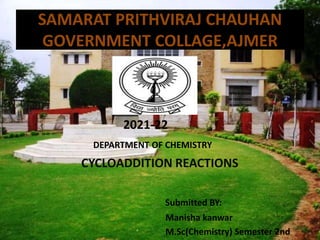
Cycloaddition Reactions
- 1. SAMARAT PRITHVIRAJ CHAUHAN GOVERNMENT COLLAGE,AJMER 2021-22 DEPARTMENT OF CHEMISTRY CYCLOADDITION REACTIONS Submitted BY: Manisha kanwar M.Sc(Chemistry) Semester 2nd
- 2. CONTENTS • Cycloaddition reaction. • Facts of cycloaddition reaction. • Terminology- supra-antra mode Symmetry • F.M.O method. • [ 2+2 ] cycloaddition reaction. • [4+2 ] cycloaddition reaction. • 1,3 dipolar cycloaddition reaction. • Application of cycloadditions. • Reference
- 3. CYCLOADDITION REACTIONS A cycloaddition is a reaction in which two unsaturated molecules undergo an addition reaction to yield a cyclic product . Formation of cyclic product takes place at the expence of one П bond in each of the reacting partner and gain of two sigma bonds at the end of the both components having pi bonds. Thus in this reaction there is loss of two pi bonds of the reactants and gain of two sigma bonds in the product.
- 4. THE CYCLOADDITION REACTION ARE CLASSIFIED WITH RESPECT TO THREE FACTS OF THE REACTION : (i) A cycloaddition reaction involves the formation of two bonds between the termini of two independent -systems, resulting in ring formation - or the reverse process. (ii) Cycloaddition reactions are stereospecific (e.g. cis/trans isomers). The stereospecificity being afforded by the suprafacial or antarafacial nature of the approach of the two -units in the transition state. (iii) The suprafacial or antarafacial process involved in the bond making process is controlled by the HOMO/LUMO interactions of the two -systems in the transition state.
- 5. • New bonds to the same side of the -system • New bonds to the opposite side of the - system
- 6. SYMMETRY IN LINEAR CONJUGATED PI- SYSTEM M-Symmetry(mirror-symmetry) • M-symmetry means plane of symmetry C2-Symmetry(centre-symmetry) • C2-symmetry means centre of symmetry
- 7. FMO METHOD In order for a cycloaddition to occur,must be bonding overlap between p orbital at the terminal carbons of each electron system ,this is where the new sigma-bonds are formed. Lets us explain this point with a [4+2] cycloaddition. Let us suppose that diene (4- component) behaves as electron donar and the dienophile (2- component)as the electron acceptor.
- 8. [2+2] CYCLOADDITION REACTION When 2 electron and 2 electron system combine together to give cycloalkene the reaction is called 2+2 cycloaddition it can occur suprafical antrafacial mode of addition.
- 9. [2+2] CYCLOADDITIONS THERMAL INDUCED
- 10. [2+2] CYCLOADDITIONS • PHOTO INDUCED-
- 11. [4+2] CYCLOADDITION REACTION • A cycloaddition reaction is the concerted bonding together of two independent pi-electron systems to form a new ring of atoms. ... The Diels-Alder cycloaddition is classified as a [4+2] process because the diene has four pi-electrons that shift position in the reaction and the dienophile has two.
- 12. [4+2] cycloaddition reaction • THERMAL INDUCED REACTION –There are two possible interactions, HOMO (diene) – LUMO (dienophile) and HOMO(Dienophile)-LUMO(diene). • 1.HOMO(Diene)-LUMO(dienophile)
- 14. [4+2] cycloaddition reaction • PHOTO INDUCED REACTION-When diene is excited by light.its HOMO becomes Ψ₃* which has m symmetry and this MO cannot overlap with LUMO of ethylene which has C₂ symmetry. • Thus photochemical Cycloaddition of [4+2] Systemis symmetry forbidden reaction.
- 15. 1,3 –DIPOLAR CYCLOADDITIONS • 1,3-Dipolar cycloadditions represent synthetically important reactions for the preparation of heterocyclic five-membered rings. They belong into the group of [4+2] cycloadditions according to the Woodward-Hoffmann classification. •
- 16. • INTERACTION BETWEEN HOMO OF 1,3-DIPOLE AND LUMO OF DIPOLARPHILE
- 17. APPLICATIONS OF CYCLOADDITIONS • N1 unit transfer reaction to C–C double bonds. • [3+2] Cycloaddition of α, β-unsaturated metal-carbene complexes. • Formal [3+3] cycloaddition approach to natural product synthesis. • Development of new methods for the construction of heterocycles based on cycloaddition reaction of 1,3- dipoles. • Cycloreversion approach for preparation of large π- conjugated compounds. • Transition metal-catalyzed or mediated [5+1] cycloadditions. https://www.wiley.com/en- us/Methods+and+Applications+of+Cycloaddition+Reactions+in+Organic+Syntheses-p-9781118299883
- 18. REFERENCE • Advance organic chemistry- DR. JAGDAMBA SINGH(Pragati edition). https://www.goodreads.com/work/editions/66293573-advance-organic-chemistry • Cycloaddition reaction in organic synthesis- W.Carruthers. Print ISBN:9783527301591 |Online ISBN:9783527600250 |DOI:10.1002/3527600256